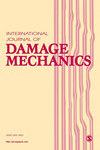An improved micromechanical model for multiscale fiber reinforced ultra-high performance concrete: From hydration, dehydration to thermal damage
IF 3.9
2区 工程技术
Q2 MATERIALS SCIENCE, MULTIDISCIPLINARY
引用次数: 0
Abstract
Multiscale fiber-reinforced ultra-high performance concrete (MSFUHPC) was recently developed to obtain the desired thermal and mechanical properties for engineering structures suffering from fire accidents. Quantitative methods to characterize the evolution of its thermal damage are necessary to design MSFUHPC and remain to be presented. This study presents an improved micromechanical model focusing on the material's stiffness from hydration through dehydration to thermal damage. MSFUHPC is renowned for its exceptional mechanical properties and durability; however, its susceptibility to thermal degradation poses significant challenges, particularly in fire scenarios. The integration of multiscale fibers—comprising steel, polyethylene, and carbon fibers and carbon nanotubes—alongside lightweight aggregates such as fly ash cenospheres, enhances the material's performance subjected to elevated temperatures. The proposed micromechanical model captures the complex interactions between the fibers, sand and cement matrix at various scales. By considering the effects of hydration and dehydration, the model offers valuable insights into the mechanisms leading to thermal damage during thermal exposure. Moreover, two Weibull probabilistic models are introduced to characterize the evolution of thermal cracking and sand debonding. Experimental studies are carried out to estimate the thermal and mechanical properties of MSFUHPC, thereby validating the model's feasibility. The results indicate that the multiscale fiber reinforcement significantly mitigates thermal damage. These findings underscore the importance of optimizing fiber and aggregate combinations to achieve superior fire resistance. Moreover, the proposed micromechanical model can serve as input parameters for thermomechanically coupled analysis of structures and components.一种改进的多尺度纤维增强超高性能混凝土微观力学模型:从水化、脱水到热损伤
多尺度纤维增强超高性能混凝土(MSFUHPC)是近年来发展起来的一种能够在火灾事故中获得理想热力学性能的工程结构材料。表征其热损伤演变的定量方法对于设计MSFUHPC是必要的,但仍有待提出。本研究提出了一个改进的微观力学模型,关注材料从水化到脱水到热损伤的刚度。MSFUHPC以其卓越的机械性能和耐用性而闻名;然而,它对热降解的易感性带来了重大挑战,特别是在火灾情况下。多尺度纤维(包括钢、聚乙烯、碳纤维和碳纳米管)与轻质聚集体(如粉煤灰微球)的集成,增强了材料在高温下的性能。所提出的微观力学模型捕捉了纤维、砂和水泥基质在不同尺度上的复杂相互作用。通过考虑水化和脱水的影响,该模型为热暴露过程中导致热损伤的机制提供了有价值的见解。此外,还引入了两个Weibull概率模型来描述热裂和砂土剥离的演化过程。通过实验研究估计了MSFUHPC的热性能和力学性能,从而验证了模型的可行性。结果表明,多尺度纤维增强能显著减轻热损伤。这些发现强调了优化纤维和骨料组合以获得优异耐火性能的重要性。此外,所提出的微力学模型可作为结构和构件热-力耦合分析的输入参数。
本文章由计算机程序翻译,如有差异,请以英文原文为准。
求助全文
约1分钟内获得全文
求助全文
来源期刊

International Journal of Damage Mechanics
工程技术-材料科学:综合
CiteScore
8.70
自引率
26.20%
发文量
48
审稿时长
5.4 months
期刊介绍:
Featuring original, peer-reviewed papers by leading specialists from around the world, the International Journal of Damage Mechanics covers new developments in the science and engineering of fracture and damage mechanics.
Devoted to the prompt publication of original papers reporting the results of experimental or theoretical work on any aspect of research in the mechanics of fracture and damage assessment, the journal provides an effective mechanism to disseminate information not only within the research community but also between the reseach laboratory and industrial design department.
The journal also promotes and contributes to development of the concept of damage mechanics. This journal is a member of the Committee on Publication Ethics (COPE).
 求助内容:
求助内容: 应助结果提醒方式:
应助结果提醒方式:


